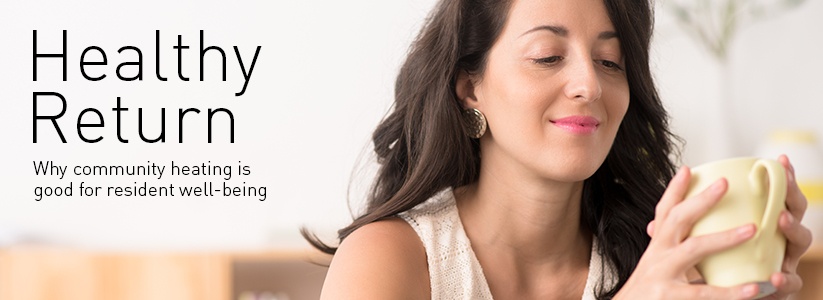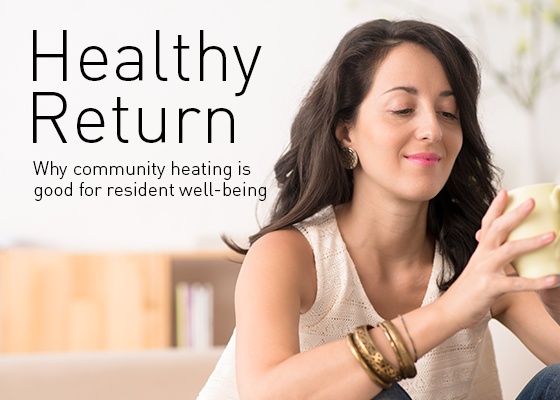
Millions of households are unable to keep their homes warm in the winter. We look at how this happens, the health problems caused, and how community heat improves tenant well-being.
 Government health experts recommend a minimum indoor temperature of 18 degrees in order to keep people healthy. However, millions of UK households are in “fuel poverty” – or unable to keep their homes warm enough during the cold months.
Government health experts recommend a minimum indoor temperature of 18 degrees in order to keep people healthy. However, millions of UK households are in “fuel poverty” – or unable to keep their homes warm enough during the cold months.
One or more of the following three factors will leave people in this desperate situation:
- Poor energy-efficiency of their property
- Relatively high energy costs
- Relatively low household income
The Association for the Conservation of Energy and the campaign group, Energy Bill Revolution, estimate that at the start of 2014, 6.59m households (a quarter) spent more than 10% of its income heating its home – one basic definition of fuel poverty. The figure is up from 5.86m a year earlier.
The current government records a much lower figure (2.28m) as there are several other ways of measuring fuel poverty but, even according to its own figures, the situation is not improving.
Despite this, the Department for Energy and Climate Change (DECC) says it wants to bring as many homes “as is reasonably practicable” up to a minimum energy efficiency (EPC) rating of band C by 2030.
According to the lettings agency Knight Frank, recent changes to legislation will mean private rented landlords will not be able to let out F or G-rated properties by 2018.
The health impacts of cold homes
Fuel poverty kills. Last year, around 5,500 people in England and Wales died because their homes were too cold. The World Health Organisation estimates that 30% of deaths above the average during the cold season were attributable to cold indoor temperatures.
That’s because cold temperatures cause blood vessels to narrow, driving up blood pressure making cardiovascular diseases (heart disease, strokes) and respiratory conditions (flu-like disease, asthma, Chronic Obstructive Pulmonary Disease) more likely or severe.
Those most at risk include older people (particularly in larger homes), the disabled, and those with long-term illnesses.
Overly cold homes lead to other negative health impacts including stress and depression – the root of harmful behaviours including poor food choices and drug and alcohol abuse. In fact, research by The UK Health Forum shows that investing £1 in improving affordable warmth delivered a 42 pence saving in health costs for the NHS.
How community heating can help
As many residents of social landlords are likely to be in fuel poverty due to their low household income, social landlords can have a big impact on tackling this national problem.
Experience shows that community and district heating schemes can help customers significantly reduce the cost of their heating bills compared with gas or electric central heating. That’s because buyers in these schemes can benefit from increased efficiency and background heat in the network. They can also take advantage of bulk buying at commercial rates, with savings being passed on to their tenants.
Community heating puts social landlords in control by allowing them to put in monitoring schemes to protect the vulnerable.
It is true that especially where electricity heating was the only alternative to community heating, the later is significantly more cost effective. Background heating in communally-heated blocks does offer a safety net as there is always a low level of heat available.
What’s more, experts are developing alternative forms of fuel, some cheaper than gas, and community schemes will be in a good position to take advantage of them as they emerge.
Too many social tenants on heat networks are stuck in fuel poverty. The 75% of customers who pay a flat-rate charge for their heat, no matter how much they use, are charged up to twice as much as those on a metered system. (See these top community heating shemes for some examples).
With greater knowledge about the heat they are using, consumers can tailor usage to fit their budgets. Once they are in the know, they are able to heat their homes only when it matters, saving money in the process. The government has introduced the Heat Network Regulations, that make meters and transparent bills a legal requirement.
Monthly billing improves consumer knowledge, with PAYG being even better. Technology has made making payment easy now that you’re equipped with an in home display. In the case of some vulnerable residents, relations and careers can take on the task of keeping the heat topped up.
With the latest technology, they can also check if the resident had the heating at a healthy temperature. The metering system can even send carers an alert if there is no activity in an property.
What next?
The government is under pressure to bring more people out of fuel poverty as well as save money in the NHS. Encouraging social landlords to boost wellness among tenants, perhaps through making it a funding requirement, would be a sensible and plausible move. Especially given the collapse of the Green Deal – its energy efficiency programme.
By installing properly metered heat networks, landlords have a vital role to play in boosting the health and finances of tenants – as well as stealing a march on any emerging regulation.
Takeaways:
- Households who can’t afford to sufficiently heat their homes are said to be in “fuel poverty”.
- Campaigning charities say up to 6.6m households are in this situation.
- Living in temperatures below 18 degrees can lead to depression, heart and breathing problems – and even kill.
- Community heating systems help social landlords fight fuel poverty and look after residents, especially the vulnerable.
- Heat meters help landlords maximise the price benefit of community heating schemes.
Community heating offers affordable, reliable heat for residents, but what about scheme operators? Poor decisions in the planning and design stage can wipe out a healthy financial return, or lead to tariffs that are too high or too low.


